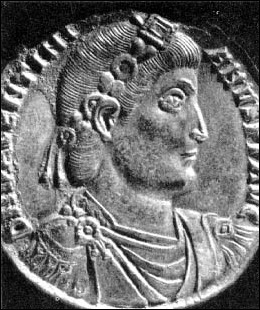I first became aware of this statue when I saw a photo of it in John Julius Norwich's "Byzantium: The Early Centuries" and saw it again recently in the BBC's "Treasures of Ancient Rome", where the statue was referred to as always looking as it did, holding a Medieval Latin cross in its right hand.
http://en.wikipedia.org/wiki/Colossus_of_Barletta
The statue is variously said to either have been found in Ravenna in the 13th century or on the coast of Barletta after the Fourth Crusade in 1204 AD, the result of a Venetian shipwreck, stuffed with loot from Constantinople.
The Dominican Friars are said to have hacked of the arms and legs to use the bronze to cast bells, in other sources the statue was said to already have been missing its arms and legs when found on the beach of Barletta.
What can be said is the arms and legs, though made to match the style of the statue, are replacements.
To me, the small Latin Cross did look "odd" against the Colossus, and the plain globe in the left hand seemed to be missing a Victory upon it.
Who the Emperor is, is still not known.
Eusebius, in his Historia Ecclesiae, in his writings on Constantine I, reported that after Constantine's victorious entry into Rome after the battle of the Milvian Bridge, the Emperor had a statue of himself created, "holding the sign of the Savior in his right hand" which may well be the Labarum.
Only the hairstyle does not resemble the well known, Colossal bust of Constantine that is now at the Capitoline Museum.
http://en.wikipedia.org/wiki/Colossus_of_Constantine
The features do look like Jovian as depicted on his coinage, and his reversal of the Pagan policies of Julian II would be an explanation for having such a Christian triumphal statue made, however Jovian never made it to Constantinople, never mind Ravenna, dying at a place called Dadastana in Asia Minor, after barely eight months of rule.
Valentinian I could be a contender, the hairstyle, the arched eye brows, cheek bones, jaw line etc.
http://en.wikipedia.org/wiki/Valentinian_I
In comparision, Gratian's features on his coins do not resemble the Colossus. Though on his coins Victory appears, he did not object to the removal of the altar of Victory from the Senate house.
http://en.wikipedia.org/wiki/Gratian
Theodosius I? Again, in comparsion with the features of Valentinian I, his does not resemble the statue's. Victory still appeared on his coinage.
http://en.wikipedia.org/wiki/Theodosius_I
Would the impoverished western Emperors of the 5th century have had the resources to make a huge statue of themselves?
Eastern Emperors such as Marcian and Leo I are also suggested, but unless the statue really was looted from Constantinople in 1204 AD, why would an eastern Emperor have a statue of themself set up in Ravenna?
Justinian I is another Emperor that the statue is thought to be of, but the well known mosaic of Justinian in the Basilica of San Vitale, Ravenna, shows him with curly hair. Not a match.
Heraclius is another suggestion, certainly on the Tremissis he had minted, his bust matches the style of the face of the Barletta Colossus.
http://www.forumancientcoins.com/catalog/roman-and-greek-coins.asp?zpg=16872
Heraclius was celebrated in the west after his victory against Persia and the recovery of Jerusalem, but by that date he is depicted as bearded.
Thinking that instead of the Medieval Latin Cross held in his right hand, the statue held the Labarum, and in his left hand it was Victory that stood upon the globe, I drew this sketch of what the Colossus may have originally looked like.
Amongst all potential imperial candidates the statue could be of, the features of Valentinian I looks the closest, and he had the means to have such a statue made.
However, if it is of Valentinian I, Ravenna would not be the original city of the statue, since it did not become the official capital of the Western Roman empire until 402 AD, 27 years after the death of Valentinian I.
The statue that was said to have been found in Ravenna in 1232 AD by order of the Holy Roman Emperor, Frederick II, is not said to have been this.
Quite how a Venetian galley, stuffed with loot from the sack of Constantinople in 1204 AD, would choose to avoid the Adriatic and head instead for the north coast of Sicily and promptly sink, seems odd.
Maybe the statue was taken as loot during the Vandal sack of Rome in 455 AD, one of their boats that carried this statue, along with other "loot" being wrecked of the north Sicilian coast, en route to Carthage.
I wonder if during the sack of Rome, by the Arab emirate of Africa in 846 AD, this was part of the "loot" taken back to their new base of Palermo (conquered by them in 831 AD), and it was then that the statue was "lost" in a shipwreck of the coast of Barletta.
There was a previous example of a more famous "Colossus" being taken away for scrap by a Caliphal army.
The Colossus of Rhodes, after falling down to an earthquake in 226 BC, in 654 AD its remains were taken by the army of Caliph Muawiyah I, which had conquered Rhodes, and sold off for scrap.
Also the Norman sack of Rome in 1084 AD, may be another explanation for how an imperial statue, likely from Rome, ended up as wreckage of the north Sicilian coast, since the Normans, by 1084 AD, had control of Sicily.
Ironically, having a look through my copy of "Romano-Byzantine Armies 4th–9th Centuries" by Osprey Publishing, on page 9 is a photo of the Colossus of Barletta, where the author, David Nicolle, states that the statue probably is of Valentinian I.















